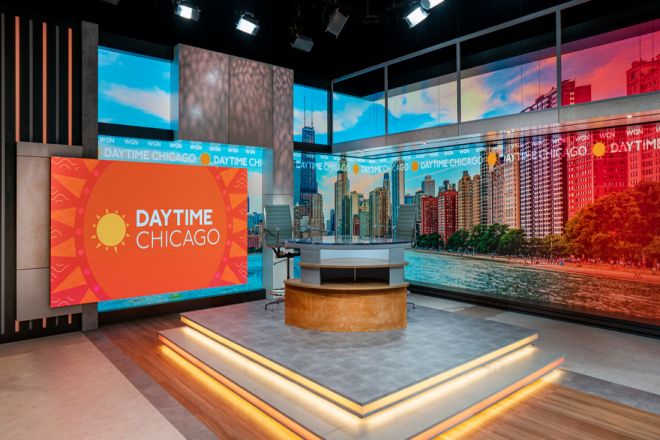مقدمة

مع التطور السريع للتكنولوجيا، أصبحت شاشات LED جزءًا لا غنى عنه في حياتنا اليومية. من الإعلانات التجارية إلى المسارح المنزلية، ومن المعارض الكبيرة إلى الأحداث الرياضية، احتلت شاشات LED مكانة مهمة في مجال العرض بفضل سطوعها العالي وتباينها العالي وعمرها الطويل.
ومع ذلك، في مواجهة المجموعة المبهرة من منتجات شاشات LED في السوق، أصبح اختيار الشاشة التي تناسب احتياجاتهم تحديًا للعديد من المستهلكين والمشترين.
1. تحليل شاشات LED عالية الدقة
دقة HD، أو دقة الوضوح العالي، تشير عادةً إلى 1080 بكسل، مما يعني 1920 بكسل أفقيًا و1080 بكسل رأسيًا. في شاشات LED، توفر دقة HD تأثير عرض واضح بما يكفي لتلبية احتياجات معظم التطبيقات اليومية. سواء كنت تشاهد مقاطع الفيديو أو تتصفح الصور أو تعرض النصوص، يمكن لدقة HD أن تجلب تجربة بصرية جيدة.
1) تحليل المزايا
تكلفة منخفضة نسبيًا: مقارنة بالشاشات عالية الدقة مثل 4K و8K، تتمتع شاشات HD بتكاليف إنتاج أقل، وبالتالي يكون سعرها أكثر معقولية. وهذا يجعل شاشات HD الخيار الأول للمستخدمين ذوي الميزانيات المحدودة.
واضح بما فيه الكفاية للمشاهدة العادية والاحتياجات غير المهنية: بالنسبة لمعظم المستخدمين العاديين، فإن دقة HD كافية لتلبية احتياجات المشاهدة اليومية. سواء كان الأمر يتعلق بمسرح منزلي أو إعلان تجاري أو شاشة مكتب، يمكن لشاشة HD توفير جودة صورة واضحة ودقيقة.
2) تحليل العيوب
دقة منخفضة نسبيًا: بالمقارنة مع شاشات عالية الدقة مثل 4K و8K، فإن دقة HD تحتوي على عدد صغير نسبيًا من البكسل. وهذا يعني أنه عند عرض بعض المشاهد التي تتطلب تفاصيل عالية الدقة، مثل التصوير الفوتوغرافي عالي الدقة وإنتاج الأفلام والتلفزيون الاحترافي، قد تبدو شاشات HD عاجزة.
قد تظهر حبيبات البكسل على شاشات كبيرة الحجم: عندما يكون حجم شاشة HD عالية الدقة كبيرًا جدًا، نظرًا للمسافة الكبيرة نسبيًا بين وحدات البكسل، فقد تحتوي الصورة على حبيبات بكسل واضحة. تكون هذه الظاهرة واضحة بشكل خاص عند المشاهدة عن قرب وقد تؤثر على تجربة المشاهدة للمستخدم. لذلك، عند اختيار شاشة LED كبيرة الحجم، من الضروري الموازنة بين الدقة والحجم.
2. تحليل شاشة LED بدقة 4K

دقة 4K، المعروفة أيضًا باسم دقة الوضوح العالي للغاية (UHD)، لها دقة قياسية تبلغ 3840 × 2160 بكسل. وهذا يعني أن هناك 3840 بكسل في الاتجاه الأفقي و2160 بكسل في الاتجاه الرأسي، بإجمالي 8.29 مليون بكسل. في شاشات العرض LED، تتمتع دقة 4K بتحسن كبير في جودة الصورة مقارنة بدقة HD التقليدية (1080 بكسل).
تجعل كثافة البكسل العالية الصورة أكثر دقة، والألوان أكثر تشبعًا، والتفاصيل أكثر بروزًا.
1) تحليل المزايا
- دقة عالية وتفاصيل الصورة أكثر ثراءً:
يمكن لشاشات العرض LED بدقة 4K تقديم تأثيرات صور أكثر دقة وواقعية. سواء كنت تشاهد أفلامًا عالية الدقة أو تلعب ألعابًا على شاشات أو تعرض صورًا عالية الدقة، يمكن للمستخدمين تجربة تجربة بصرية غير مسبوقة.
- مناسبة لمجموعة متنوعة من سيناريوهات التطبيق:
بفضل الأداء الممتاز لشاشات العرض LED بدقة 4K في جودة الصورة، فهي مناسبة لمجموعة متنوعة من سيناريوهات التطبيق.
على سبيل المثال، يمكن للعروض التجارية جذب المزيد من الاهتمام وتعزيز صورة العلامة التجارية؛ وفي المسارح، يمكنها توفير تجربة مشاهدة أكثر غامرة، مما يجعل الجمهور يشعر وكأنه في عالم الأفلام.
2) تحليل العيوب
التكلفة المرتفعة نسبيًا: مقارنة بشاشات العرض LED بدقة HD، ستزيد تكلفة إنتاج شاشات العرض بدقة 4K، وبالتالي فإن سعر البيع مرتفع نسبيًا. وقد يتجاوز هذا النطاق الميزانية لبعض المستخدمين.
متطلبات عالية لأداء الأجهزة: لدعم التشغيل السلس بدقة 4K، يلزم دعم أجهزة ذات أداء أعلى، مثل معالج رسوميات أقوى وذاكرة أكبر. وقد يؤدي هذا إلى زيادة تكلفة الاستثمار الإجمالية للمستخدم. وفي الوقت نفسه، إذا كان أداء الأجهزة غير كافٍ، فقد يتسبب ذلك في حدوث مشكلات مثل تجميد الشاشة والتأخير، مما يؤثر على تجربة المشاهدة.
3. تحليل شاشة LED بدقة 8K
يصل معيار دقة 8K إلى 7680×4320 بكسل، وهو ما يعني وجود 7680 بكسل أفقيًا و4320 بكسل رأسيًا، بإجمالي أكثر من 33 مليون بكسل.
في شاشات LED، توفر دقة 8K تجربة بصرية لا مثيل لها. كل بكسل أدق، مما يجعل تفاصيل الصورة أكثر ثراءً والألوان أكثر اكتمالاً. يمكن للمستخدمين الشعور بوضوح ودقة غير مسبوقة كما لو كانوا داخل الصورة.
1) تحليل الميزة
- دقة عالية للغاية:
تتميز شاشة LED بدقة 8K بكثافة بكسل عالية للغاية، مما يرفع دقة الصورة إلى مستوى جديد. سواء كان نصًا أو صورًا أو مقاطع فيديو، يمكنها عرض المزيد من التفاصيل والملمس.
- مناسب للعرض عالي الجودة:
بفضل ميزة جودة الصورة التي تتمتع بها دقة 8K، فهي مناسبة بشكل خاص للعرض عالي الجودة والسينما الاحترافية وغيرها من المناسبات التي تتطلب جودة صورة عالية للغاية. على سبيل المثال، يمكن للآثار الثقافية الثمينة المعروضة في المتحف والعرض الخلفي في غرفة المؤتمرات عالية الجودة أن تجلب تأثيرات بصرية صادمة للجمهور.
2) تحليل العيوب
التكلفة العالية: تكلفة إنتاج شاشة LED بدقة 8K أعلى بكثير من تكلفة إنتاج شاشة بدقة HD و4K، وبالتالي فإن سعر البيع مرتفع نسبيًا. بالنسبة للمستخدمين العامين، قد لا يكون سعرها المرتفع فعالاً من حيث التكلفة.
متطلبات أداء الأجهزة العالية: من أجل دعم التشغيل السلس وعرض دقة 8K، هناك حاجة إلى معدات أجهزة عالية الأداء للغاية، مثل معالجات الرسومات عالية الأداء والذاكرة ذات السعة الكبيرة وما إلى ذلك. وهذا لا يزيد من تكلفة استثمار المستخدم فحسب، بل يفرض أيضًا تحديًا كبيرًا لمعدات الأجهزة الموجودة.
دعم السوق المحدود: هناك عدد قليل نسبيًا من الأجهزة والمحتوى الذي يمكنه دعم دقة 8K في السوق، مما يحد أيضًا من نطاق تطبيق شاشة LED بدقة 8K إلى حد ما. ومع ذلك، مع تقدم التكنولوجيا وتطور السوق، أعتقد أن شاشات LED بدقة 8K سيتم استخدامها على نطاق أوسع في المستقبل.
4. اقتراحات الاختيار
1) اختر وفقًا لسيناريو التطبيق.
عند اختيار شاشة LED، عليك أولاً مراعاة سيناريوهات التطبيق الخاصة بها. تتطلب السيناريوهات المختلفة متطلبات مختلفة فيما يتعلق بدقة شاشات العرض LED.
- عرض الإعلان:
بالنسبة للوحات الإعلانية الخارجية أو شاشات الإعلانات التجارية، عادة ما تكون دقة HD كافية بسبب مسافة المشاهدة الطويلة. ومع ذلك، إذا كانت اللوحة الإعلانية كبيرة أو تحتاج إلى عرض صور ومقاطع فيديو عالية الدقة، فإن دقة 4K ستوفر تجربة بصرية أفضل.
- عرض سينمائي:
بالنسبة للمسارح، تعد جودة الصورة أمرًا بالغ الأهمية. أصبحت دقة 4K هي المعيار السائد لعرض المسارح الحالية، بينما توفر دقة 8K تجربة مشاهدة أكثر تطرفًا. مع مراعاة التكلفة والدعم الفني، يمكن للمسارح اختيار الدقة المناسبة وفقًا للاحتياجات الفعلية والميزانية.
- عرض المعرض:
في المعارض، تُستخدم شاشات LED عادةً لعرض الصور عالية الدقة أو مقاطع الفيديو أو المحتوى التفاعلي. ولجذب انتباه الجمهور، ستجلب الشاشات ذات الدقة الأعلى تأثيرات عرض أفضل. ولكن هناك عوامل أخرى يجب مراعاتها مثل التكلفة ودعم الأجهزة.
2) ضع في اعتبارك عوامل الميزانية
تختلف تكلفة شاشات LED ذات الدقة المختلفة بشكل كبير. عادةً ما تكون تكلفة الشاشات ذات الدقة العالية أقل ومناسبة للمستخدمين ذوي الميزانيات المحدودة. تكون تكلفة الشاشات ذات الدقة 4K و8K أعلى ولكنها توفر جودة صورة وتجربة بصرية أعلى. يحتاج المستخدمون إلى اختيار الدقة المناسبة بشكل معقول بناءً على ميزانيتهم الخاصة.
3) اتجاهات تطوير التكنولوجيا
مع التطور المستمر للعلوم والتكنولوجيا، تتحسن تقنية شاشات LED باستمرار. وفي المستقبل، يمكننا أن نتوقع ظهور تقنيات مثل الدقة الأعلى والحجم الأكبر ومعدل التحديث الأعلى.
عند اختيار شاشة LED، يحتاج المستخدمون أيضًا إلى مراعاة اتجاه تطوير التكنولوجيا. إذا سمحت الميزانية وكانت هناك متطلبات عالية لجودة الصورة، فإن اختيار شاشة بدقة 4K أو 8K سيلبي بشكل أفضل الاحتياجات المستقبلية. في الوقت نفسه، من الضروري أيضًا الانتباه إلى تطوير وتطبيق التقنيات الجديدة حتى يمكن ترقيتها واستبدالها عند الضرورة.
خاتمة
باختصار، تتمتع شاشات LED ذات الدقة العالية 4K و8K بثلاث خصائص وسيناريوهات قابلة للتطبيق. عند اختيار شاشة LED، نحتاج إلى النظر بشكل شامل في عدة عوامل مثل سيناريوهات التطبيق والميزانيات واتجاهات تطوير التكنولوجيا.
بالنسبة لمستخدمي المنازل بشكل عام، فإن شاشات LED بدقة HD كافية لتلبية احتياجات المشاهدة والترفيه اليومية، بينما بالنسبة للشاشات التجارية والمسارح الاحترافية والمناسبات الأخرى ذات المتطلبات العالية لجودة الصورة، فإن شاشات LED بدقة 4K أو حتى 8K يمكن أن تعرض بشكل أفضل تأثيرات الصورة الممتازة وتجربة الرؤية.
أخيرًا، إذا كنت تريد معرفة المزيد عن شاشات LED، يرجى الحصول على اتصال معنا.
